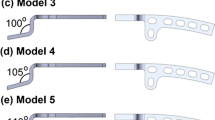Abstract
Purpose
While Clavicle hook plates have demonstrated favorable results regarding bone and shoulder function, their design can potentially lead to complications due to pressure concentration at the plate's tip. This study aims to investigate the impact of different hook implantation angles on the contact surface area between the hook plate and acromion, with the goal of minimizing mismatch and maximizing contact surface area.
Methods
Twenty soft shoulder cadavers were included in the study, and the contact surface area of the hook plate was measured in different positions based on the hook implantation angle.
Results
The results showed variations in compatibility, width, and length of the contact surface area depending on the hook implantation angle and the medial or lateral row placement. The lateral row generally demonstrated superior compatibility (84.0% vs 46.67%, p-value < 0.001), with a broader contact area (3.55 ± 0.08 mm vs 3.09 ± 0.10 mm, p-value = 0.004) and a longer contact area (7.36 ± 0.19 mm vs 5.10 ± 0.23 mm, p-value < 0.001) at specific angles. A detailed analysis of the lateral position revealed that the zero angle of implantation resulted in the greatest contact surface area, measuring 3.91 ± 0.70 mm in width (p value = 0.083) and 8.85 ± 1.24 mm in length (p value < 0.001).
Conclusion
Placing the hook laterally and at the zero position according to the hook implantation angle can maximize contact surface area, may reduce stress concentration, and minimize complications in hook plate fixation. Further research and consideration of anatomical variations are warranted to refine the placement technique and enhance patient outcomes.
Level of Evidence
Level V evidence.




Similar content being viewed by others
Availability of data and material
Not applicable.
Code availability
Not applicable.
References
Synthes (2021) 3.5 mm LCP clavicle hook plates surgical technique. Llnwd.net. http://synthes.vo.llnwd.net/o16/LLNWMB8/US%20Mobile/Synthes%20North%20America/Product%20Support%20Materials/Technique%20Guides/DSUSTRM10161127_Rev%20B.pdf. Accessed 20 Jan 2024
Asadollahi S, Bucknill A (2019) Hook plate fixation for acute unstable distal clavicle fracture: a systematic review and meta-analysis. Orthop Trauma 33(8):417–422
Tiren D, Bemmel AJ, Swank DJ, Linden FM (2012) Hook plate fixation of acute Displaced lateral clavicle fracture: mid-term results and a brief literature overview. J Orthop Surgery Res 7(2):1–8
Wu X et al (2020) Digital technology combined with 3D printing to evaluate the matching performance of AO clavicular hook plates. Indian J Orthop 54:141–147
Wu X et al (2020) 3D printed model used as preoperative tool for treating acromioclavicular joint dislocation with pre-contoured clavicle hook plate: technical note. OrthopUnfall 158:221–226
ElMaraghy AW, Devereaux MW, Ravichandiran K, Agur AM (2010) Subacromial morphometric assessment of the clavicle hook plate injury. Int J Care injured 41:613–619
Yoon JP, Lee YS, Song GS, Oh JH (2017) Morphological analysis of acromion and hook plate for the fixation of acromioclavicular joint dislocation. Knee Surg Sports Traumatol Arthrosc 25:980–986
Liu J et al (2021) Biomechanical analysis of a novel clavicular hook plate for the treatment of acromioclavicular joint dislocation: a finite element analysis. Comput Biol Med 133:1–7
Shih CM, Huang KC, Pan CC, Lee CH, Su KC (2015) Biomechanical analysis of acromioclavicular joint dislocation treated with clavicle hook plates in different lengths. Int Orthop 39:2239–2244
Hung LK, Su KC, Lu WH, Lee CH (2017) Biomechanical analysis of clavicle hook plate implantation with different hook angles in the acromioclavicular joint. Int Orthop 41:1663–1669
Acknowledgements
We would like to thank Jaruwat W. and Noppadol P. for his assistance and guidance in this research.
Funding
There is no funding source.
Author information
Authors and Affiliations
Contributions
Pamok S. and Thanawan.J performed the dissections, identification and measurements, including repeated mensuration with different intervals to increase intra- and inter-observer reliability. Peerapong P. and Vajarin P. were involved in planning and supervised the work. Pamok S. processed the experimental data, performed the analysis, drafted the manuscript and designed the figures. Rosarin R. prepared the samples including cadaver preservation, sectioning, choosing the qualified cadaver and also with the crucial step of planning sequences to perform this cadaveric study. Chumnan I. aided in interpreting the results and worked on the manuscript. All authors discussed the results commented and final approved on the manuscript.
Corresponding author
Ethics declarations
Conflict of interest
This research was conducted without external funding, and the authors affirm that they have no conflicts of interest.
Ethical approval
Ethical approval to perform and report this study was obtained from institutional review board, police general hospital. All procedures performed in studies were in compliance with the principles outlined in the Declaration of Helsinki, the Belmont report, subsequent amendments, or equivalent ethical standards.
Consent for publication
All authors have approved the manuscript and provided consent for the publication of all its contents.
Informed consent
Informed consent was obtained from all individual participants included in the study.
Additional information
Publisher's Note
Springer Nature remains neutral with regard to jurisdictional claims in published maps and institutional affiliations.
Rights and permissions
Springer Nature or its licensor (e.g. a society or other partner) holds exclusive rights to this article under a publishing agreement with the author(s) or other rightsholder(s); author self-archiving of the accepted manuscript version of this article is solely governed by the terms of such publishing agreement and applicable law.
About this article
Cite this article
Saengsirinavin, P., Iamsirikulmit, C., Piyapittayanun, P. et al. Optimizing hook implantation angle of the clavicular hook plate: a cadaveric study. Eur J Orthop Surg Traumatol (2024). https://doi.org/10.1007/s00590-024-03981-z
Received:
Accepted:
Published:
DOI: https://doi.org/10.1007/s00590-024-03981-z




